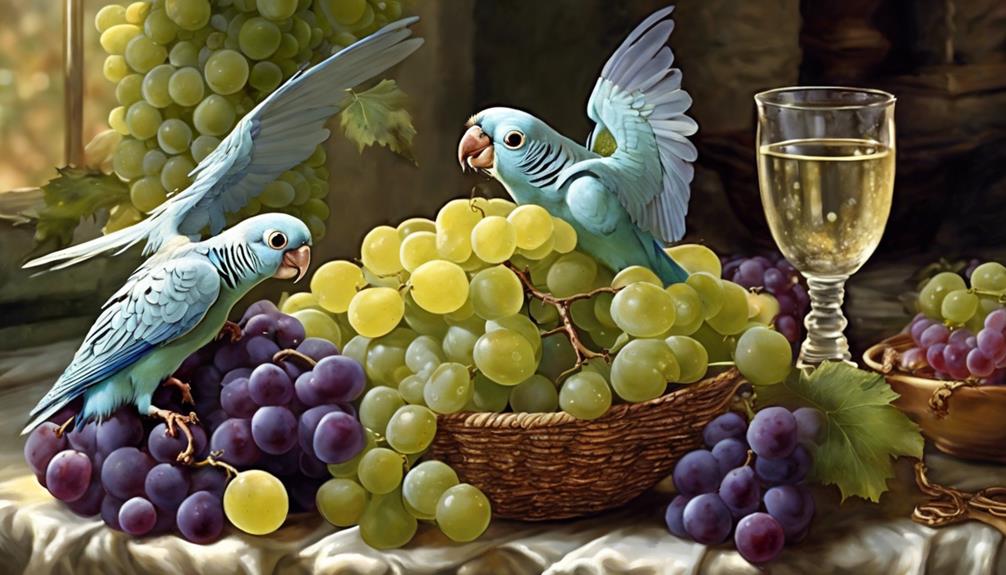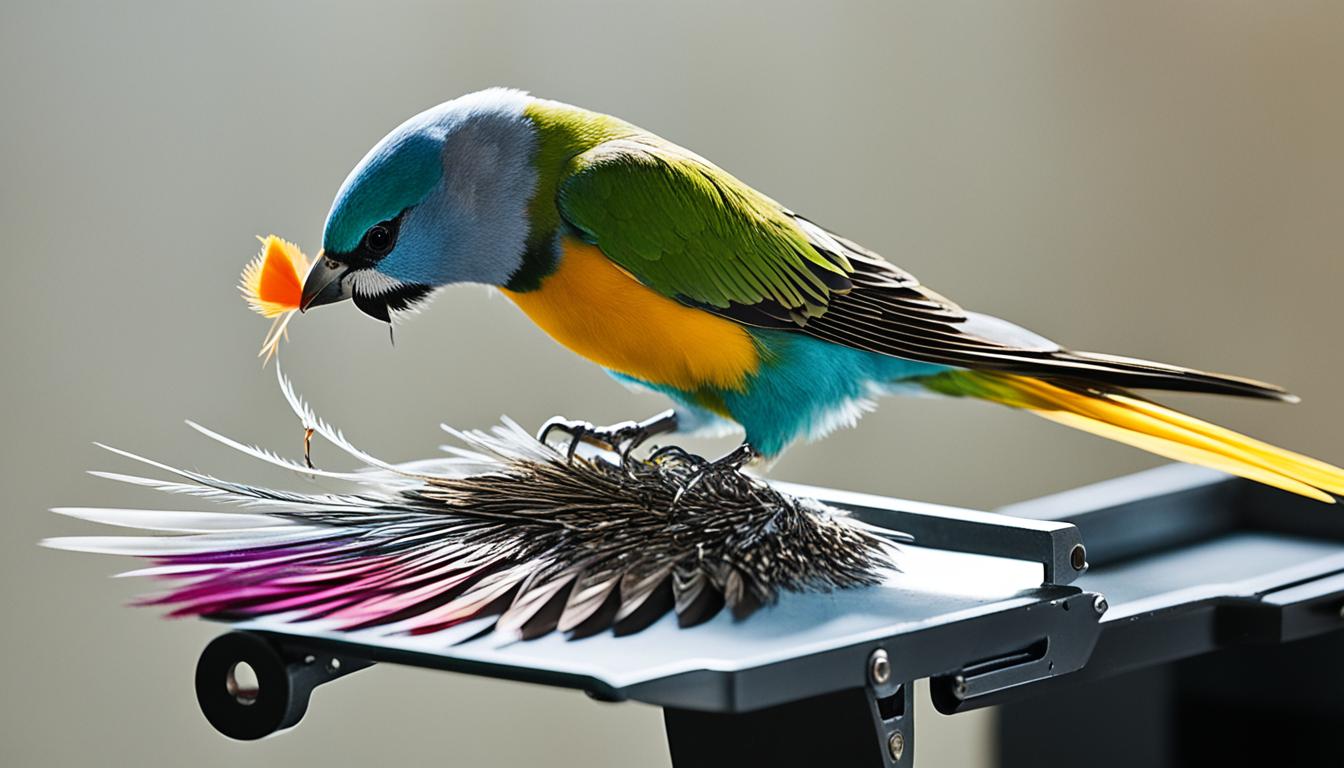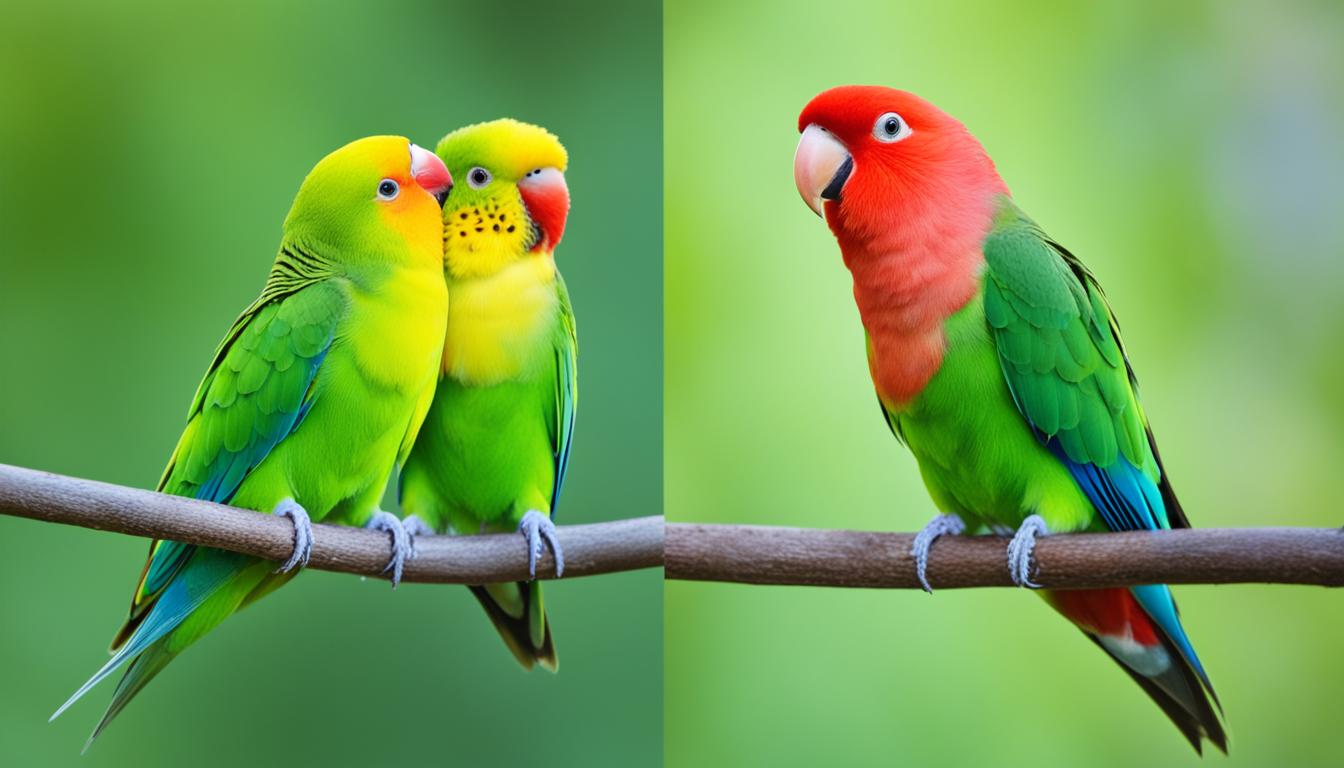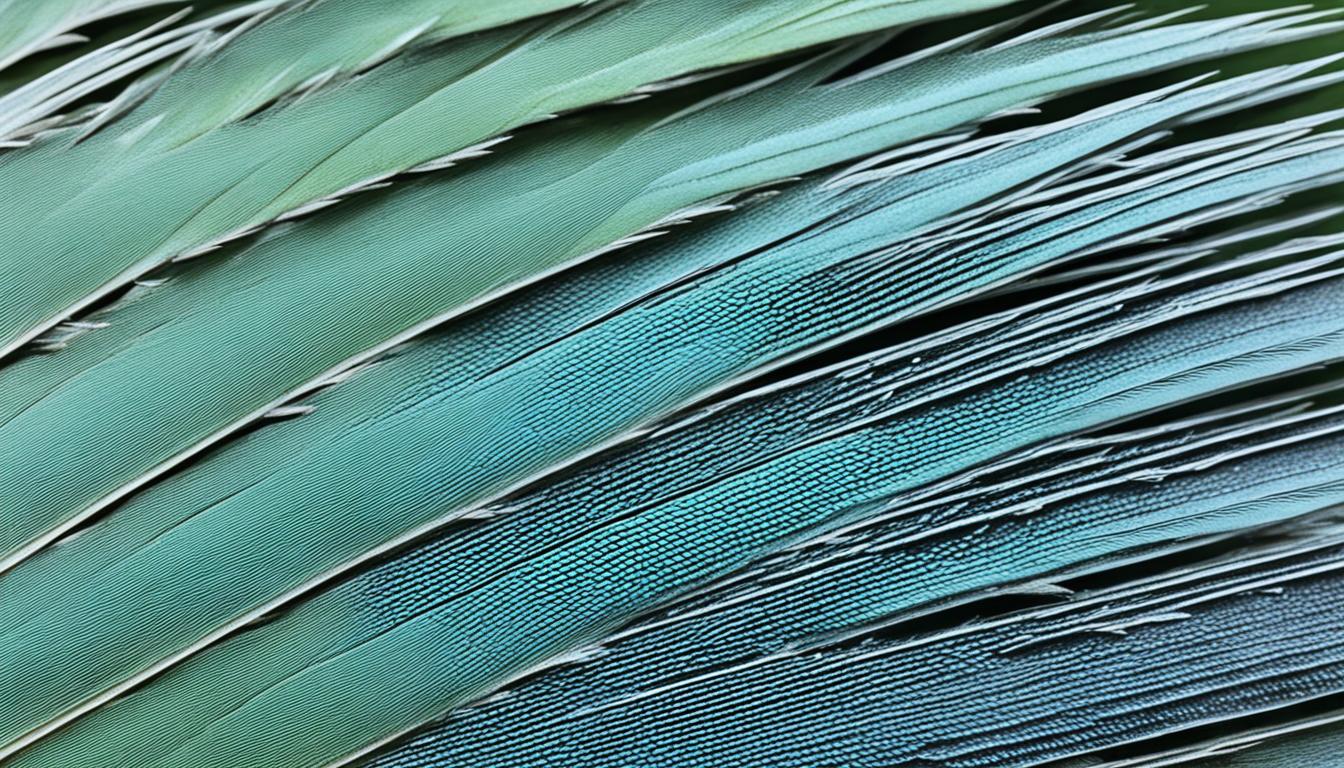We can safely feed parakeets grapes by thoroughly washing them, cutting them into small pieces, and removing the seeds. Fresh grapes are the best option, and we should pay attention to our bird’s response and adjust the portion sizes as needed. It is crucial to monitor their behavior and digestion after they consume grapes. It is important to remember that incorporating grapes as a treat in a balanced diet is essential for our parakeet’s well-being.
Additional details can help enrich your feathered friend's diet.
Key Takeaways
- Wash grapes thoroughly to remove pesticides.
- Cut grapes into small, bite-sized pieces.
- Remove all seeds before offering.
- Monitor parakeet's reaction and adjust serving sizes.
- Offer fresh grapes as a healthy snack option.
Grapes as a Safe Parakeet Treat
Grapes are occasionally recommended as a vital treat for parakeets, but moderation and careful observation are important when introducing them into your bird's diet. Parakeets can enjoy seedless grapes as a healthy snack option. These fruits offer some benefits, such as being a good source of hydration and essential nutrients. However, it's essential to remember that grapes shouldn't make up a significant portion of your parakeet's diet. Observing any changes in behavior or digestion after your parakeet eats grapes is vital to make sure they're well-tolerated.
When considering dried grapes, also known as raisins, for your parakeet, remember that they can be a suitable treat as well. However, due to their concentrated sugar content, it's important to limit the serving size to prevent any potential health issues. By offering dried grapes in moderation, you can provide your parakeet with a tasty and enjoyable snack without compromising their overall well-being.
Preparing Grapes for Parakeets
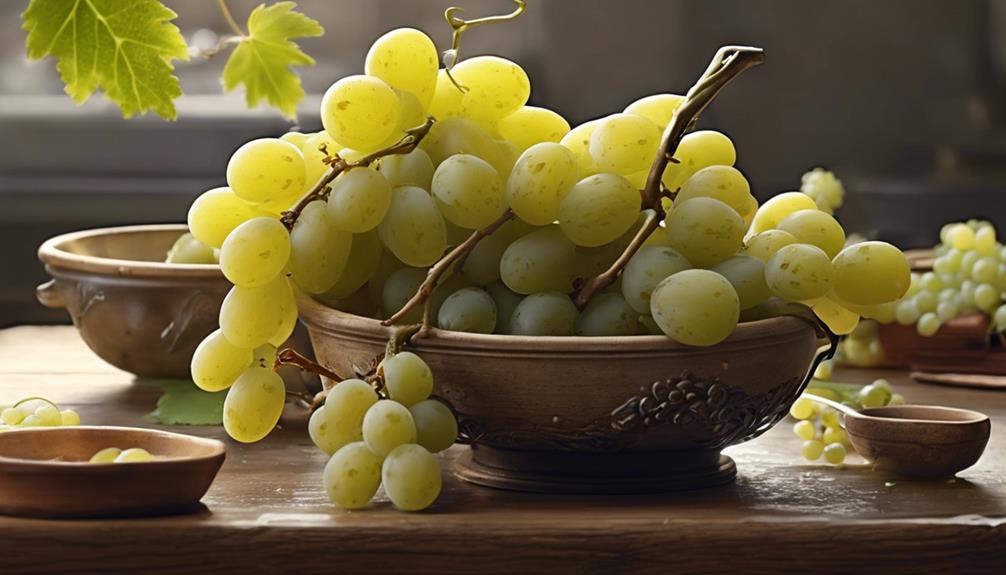
After considering the importance of incorporating grapes into a parakeet's diet with caution, the next step involves properly preparing this fruit to guarantee secure consumption for your feathered friend.
Begin by thoroughly washing the grapes to eliminate any pesticides or chemicals that may be present on the skin. Once cleaned, carefully cut the grapes into small, bite-sized pieces to prevent any choking hazards and to make them more manageable for your parakeet to eat. Remember to remove all seeds from the grapes before offering them to your pet, as seeds can pose a danger if ingested.
Opt for fresh grapes over dried ones, as fresh fruits are more hydrating and provide essential nutrients for your bird.
To safeguard your parakeet's well-being, closely monitor their reaction to grapes and adjust serving sizes accordingly based on their preferences and digestive comfort. By following these steps, you can safely introduce this nutritious treat into your parakeet's diet.
Serving Grapes to Your Parakeet
When providing grapes to your parakeet, ensure they're fresh, firm, and free of any signs of decay.
Before feeding them, it's crucial to wash the grapes thoroughly to eliminate any pesticides or residues that could harm your feathered friend.
Remember to cut the grapes into bite-sized pieces to prevent any choking hazards.
The quantity of grapes you offer should be based on your parakeet's preferences and size, ensuring they enjoy this treat without overindulging.
Be attentive to promptly remove any uneaten grapes to prevent spoilage in your parakeet's cage, maintaining a clean and healthy environment for them.
Monitoring Grape Consumption
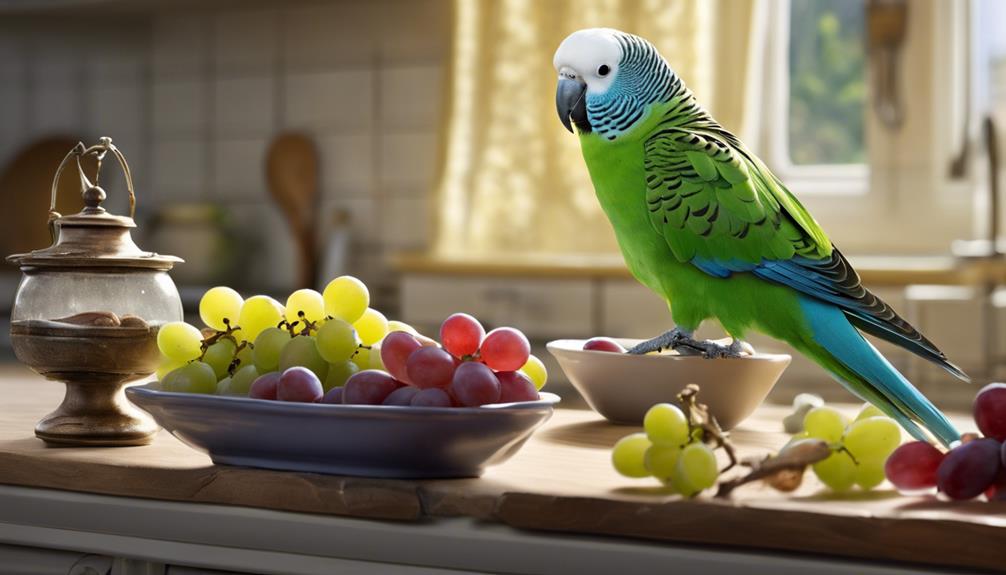
To guarantee your parakeet's well-being and diet balance, it's important to closely monitor their intake of grapes and observe any related changes in behavior or digestion. When it comes to monitoring your parakeet's grape consumption, here are some key points to keep in mind:
- Prevent Overeating: Monitor the amount of grapes your parakeet consumes to prevent overeating, which can lead to health issues and an imbalanced diet.
- Observe Behavioral and Digestive Changes: Watch for any changes in behavior or digestion after introducing grapes to your parakeet. This can indicate if the grapes are being well-tolerated or if adjustments are needed.
- Adjust Portion Sizes: Limit the quantity of grapes offered to your parakeet to avoid them dominating the diet. By observing your parakeet's response to grapes, you can adjust portion sizes accordingly to maintain a balanced diet.
Safety Tips for Feeding Grapes
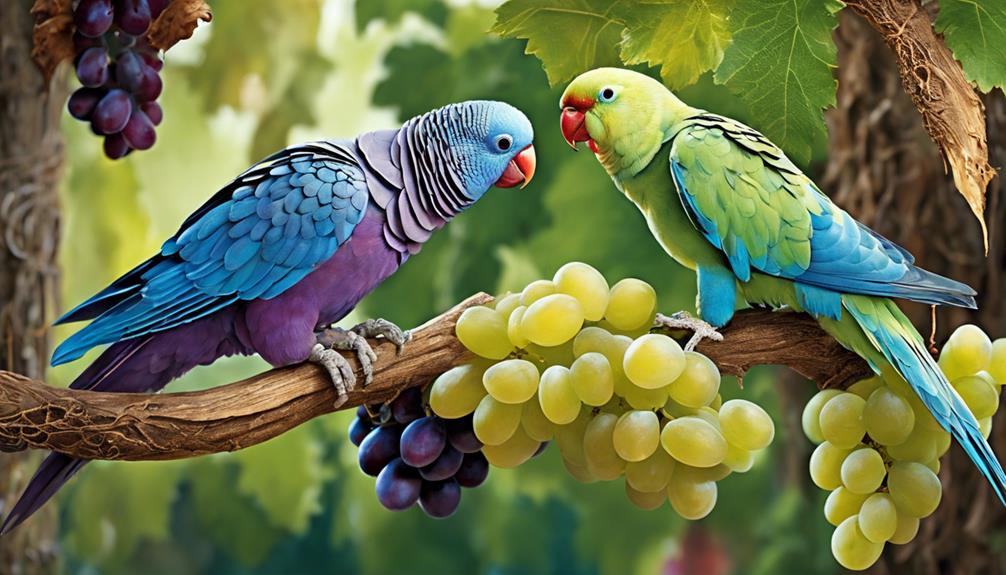
Rinsing grapes thoroughly to eliminate pesticides and chemicals is important before feeding them to parakeets. Cutting grapes into smaller, bite-sized pieces is essential to prevent choking hazards for our feathered friends.
Monitoring grape intake is crucial to prevent overfeeding and potential health issues, as grapes should be given as a treat rather than a staple in a parakeet's diet. It's significant to offer grapes as part of a varied diet that includes other suitable bird foods to guarantee our parakeets maintain overall health and well-being.
Frequently Asked Questions
Can Parakeets Eat a Grape?
Yes, parakeets can safely eat a grape. Seedless grapes are recommended for easy digestion. Grapes offer essential nutrients like potassium and vitamins A, C. Remember, moderation is key when incorporating grapes into a parakeet's diet.
How Do You Feed Parakeets Fruit?
We feed parakeets fruit by washing thoroughly, cutting into small pieces, and introducing slowly. We monitor for allergies and provide a balanced diet. Remove uneaten or spoiled fruit promptly. Variety is key for a healthy, happy parakeet.
What Is a Parakeets Favorite Human Food?
Grapes can be a parakeet's favorite human food due to their juicy sweetness. However, it's important to offer a balanced diet. We recommend introducing small amounts gradually to monitor reactions and guarantee overall health.
What Is a Parakeets Feeding Routine?
We maintain a balanced diet for parakeets, including pellets, fresh veggies, fruits like grapes, and occasional treats. Fresh water daily is essential, and we monitor food intake to prevent issues. Cleaning dishes regularly maintains hygiene.
Can Feeding Grapes to My Parakeet Cause It to Become Puffed Up?
Feeding grapes to your parakeet can be one of the reasons for a puffed up parakeet. Grapes contain toxins that can adversely affect your bird’s health, leading to symptoms like puffing up. It’s best to avoid feeding your parakeet grapes and opt for safe fruits and vegetables instead.
Conclusion
To sum up, feeding grapes to your parakeet can be an enjoyable and safe treat when done correctly.
By following the steps outlined in this guide, you can guarantee that your feathered friend enjoys this delicious snack without any risks.
Remember to always monitor their consumption and follow safety tips to keep them healthy and happy.
So go ahead, let your parakeet indulge in some juicy grapes – it's a treat they'll squawk about!
